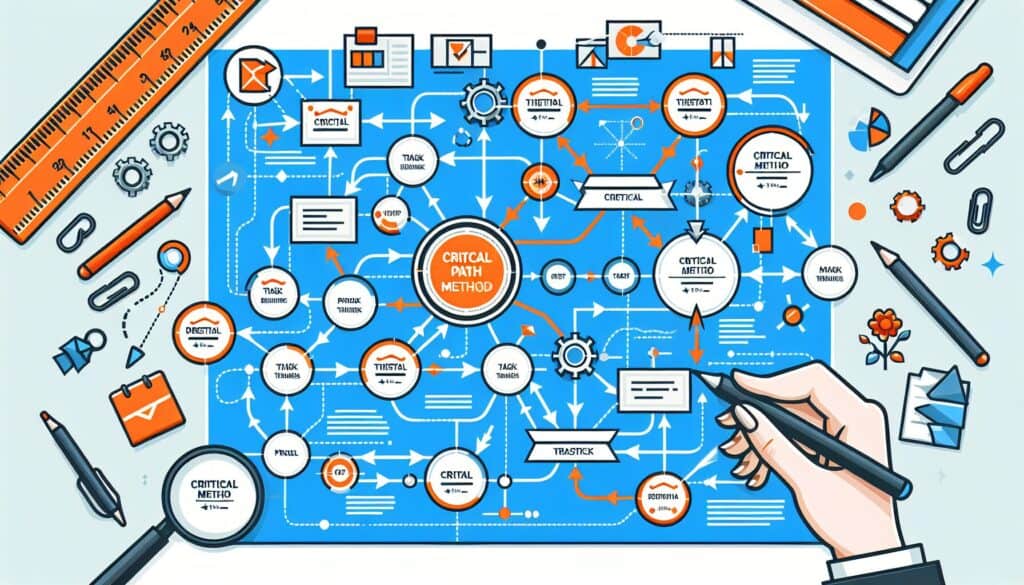A project management technique used to identify the sequence of critical tasks that determine the minimum duration of a project, and the flexibility (float or slack) of non-critical tasks.
- Methodologien: Ergonomie
Critical Path Method (CPM)

Critical Path Method (CPM)
- Agile Methodik, Kontinuierliche Verbesserung, Schlanke Fertigung, Prozess-Optimierung, Projektmanagement, Qualitätsmanagement, Ressourceneffiziente Produkte, Risikomanagement
Zielsetzung:
Wie es verwendet wird:
- Involves breaking down a project into individual tasks, estimating their durations, identifying dependencies between tasks, and then mapping out the network diagram to find the longest path of dependent tasks (the critical path). Tasks on this path have zero float.
Vorteile
- Helps determine the shortest possible project duration; Identifies critical tasks that must be managed closely to avoid delays; Allows for better resource allocation and scheduling; Provides a clear understanding of task dependencies.
Nachteile
- Relies heavily on accurate task duration estimates, which can be difficult to make; Does not inherently account for resource availability or limitations (though often used with resource leveling); Can be complex for very large projects; Does not directly manage uncertainties in task durations (unlike PERT).
Kategorien:
- Projektmanagement
Am besten geeignet für:
- Planning, scheduling, and controlling complex projects by identifying the sequence of tasks that directly impacts the project's completion date.
The Critical Path Method (CPM) is effectively utilized across various industry sectors including construction, aerospace, software development, and manufacturing, where projects consist of numerous interconnected tasks requiring regimented timelines. In construction, CPM is pivotal during the planning phase, allowing project managers to accurately estimate the time required for different segments, assess resource allocations, and plan for potential delays by mapping dependencies among tasks such as excavation, foundation work, and structural framing. In software engineering, teams might apply CPM during the development lifecycle, especially in stages involving extensive testing and deployment processes, where sequencing tasks like coding, testing, and implementation can significantly affect delivery timelines. Stakeholders involved in these initiatives typically include project managers, engineers, product designers, and stakeholders from different departments who contribute to various project phases. The methodology necessitates collaboration and communication among these participants to ensure that they are aware of dependencies that may not be immediately apparent. Tools such as Gantt charts or project management software are often used in conjunction with CPM to visualize timelines and dependencies, enhancing understanding and coordination among team members. With its ability to clarify task priorities and management focus, CPM provides an effective framework for mitigating risks related to project scheduling and execution.
Die wichtigsten Schritte dieser Methodik
- Break down the project into individual tasks by identifying all necessary activities.
- Estimate the duration of each task based on previous experience or expert judgment.
- Identify dependencies between tasks, noting which tasks must be completed before others can start.
- Create a network diagram representing tasks and their dependencies.
- Calculate the earliest start and finish times for each task.
- Determine the latest start and finish times for each task without delaying the project.
- Identify the critical path, which includes tasks with zero float and the longest total duration.
- Allocate resources effectively based on identified critical tasks and their scheduling needs.
- Monitor progress regularly against the critical path to manage potential delays swiftly.
Profi-Tipps
- Utilize software tools to automate the CPM calculations and visualize task dependencies, improving accuracy and efficiency.
- Regularly update the project schedule as tasks progress, adjusting dependencies and durations to reflect real-time changes and mitigate risks.
- Conduct a thorough risk analysis on tasks along the critical path to identify potential bottlenecks and implement mitigation strategies proactively.
Verschiedene Methoden lesen und vergleichen, Wir empfehlen die
> Umfassendes Methoden-Repository <
zusammen mit den über 400 anderen Methoden.
Ihre Kommentare zu dieser Methodik oder zusätzliche Informationen sind willkommen auf der Kommentarbereich unten ↓ , sowie alle ingenieursbezogenen Ideen oder Links.
Historischer Kontext
1949
1950
1950
1960
1960
1960
1960
1940
1950
1950
1958
1960
1960
1960
1960
(wenn das Datum nicht bekannt oder nicht relevant ist, z. B. "Strömungsmechanik", wird eine gerundete Schätzung des bemerkenswerten Erscheinens angegeben)















Verwandte Artikel
Management der Produktionsabläufe (MOM)
Fertigungsausführungssystem (MES)
Produktionslenkungsplan
Manuelle Prüfung
Bewertungsbögen für die manuelle Handhabung (MAC)
ManTRA (Instrument zur Risikobewertung manueller Tätigkeiten)